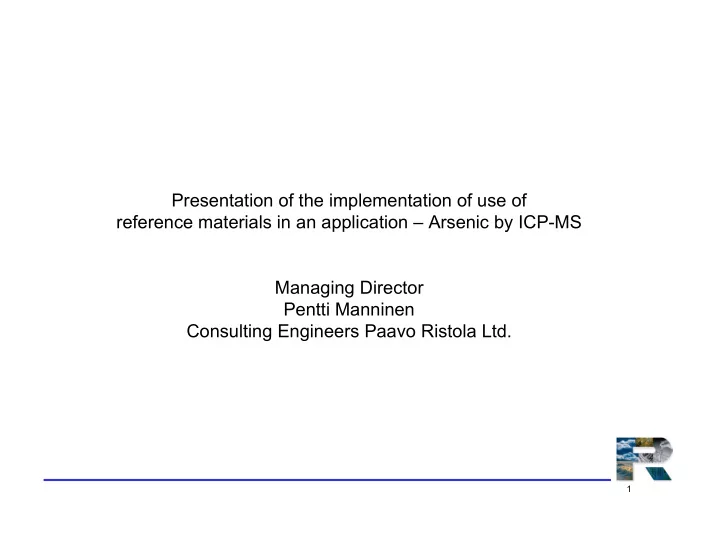

Presentation of the implementation of use of reference materials in an application – Arsenic by ICP-MS Managing Director Pentti Manninen Consulting Engineers Paavo Ristola Ltd. 1
Terveystie 2, FIN-15870 Hollola tel. +358-3-52 351 proy@ristola.com www.ristola.com 2
Laboratory for industry and power plant chemistry Environmental laboratory 3
REFERENCE MATERIALS RM Used in method: validation, calibration, estimation of measurement uncertainty, training, internal quality control, proficiency testing 4
Validity of measurement: according customer requirements, with validated methods and equipments, qualified and competent staff, traceability and measurement uncertainty, proficiency testing, QC and QA procedures, accreditation 5
Types of reference materials: RMS support measurements of: chemical composition, biological, clinical, physical, engineering, sensory properties 6
Pure substances: purity / impurities Standard solutions, gas mixtures: prepared gravimetrically, used for calibration Matrix reference materials: major, minor, trace chemical constituents, real matrices, synthetic mixtures Physico-chemical reference materials: density, viscosity, melting point etc Other: CRM RM 7
RM’s FOR ELEMENT ANALYSIS 10580 ICP Multi Element Standard VI 11355 ICP Multi Element Standard IV Perkin Elmer N812-2038 Perkin Elmer N812-2014 QC PLUS + Quality Control, VKI, QC Municipal Sludge A Custom Grade Multielement Solution CCS-1, Inorganic Ventures Custom Grade Multielement Solution CCS-2, Inorganic Ventures AccuTrace TM Reference Standard Baker Instra Analyzed Arsenic Atomic Absorption Standard 8
Reference Reference Type Type materials materials ALL-MO, ALL-MO reference water GBW 08628b simulated rain water ALLARD, reference water GRM-02 rain water from Southern Ontario ALLARD, reference water ION-20 water LGC 6176 ANT-B 2778, coal AR 1517, cement AR1517 QC- PLUS+ QCP-MTL water, heavy metals AR 2758, coal QC WW4, TOC VKI water VAPO/JPT, peat AR 5170, cement AR 5170 ASSO 3193-85 dolomitized limestone VAPO/SSLT, ash BCR 38, ash VTT 100 005/00 wood-peat ash BCR 40, coal ÄMPÄRI slag bottom slag DP 1016, paper ÄMPÄRI, Partek 152 lime stone DP 704, paper, aged ÄMPÄRI, VNJ 009510 REF DP n. 700 old paper ÄMPÄRI, ash coal fly ash GYP-A, gypsum ÄMPÄRI, coal ÄMPÄRI, wood saw dust IAEA V-10, hay ICMIX2-100, water ÄMPÄRI, cement KALKSTEIN II 8-34 lime stone ÄMPÄRI, peat ash peat fly ash LIETE, L1-6/98 sludge ÄMPÄRI, peat peat MAA, M1-6/98 soil ÄMPÄRI, peat VAPO peat NBS 1648, dust T02-218-07 REF NIST 1632b, coal NBS 1632a, NBS bituminous coal NIST 1633a, ash QCP-MTL, 03/2000 water, heavy metals NIST1632c, coal OLSO, saline reference water OLSO, laboratorio saline reference water 9
RM FOR ARSENIC ANALYSIS ICP Multi Element Standard VI CertiPUR LOT. OC316171 As (Arsenic) 100 +/- 5 mg/l; NIST Standard Reference Material SRM 3103a Batch Code 891003 10
CALIBRATION STANDARD FOR ARSENIC ANALYSIS Arsenic (III) Oxide, Purity 99.999%, Starting Material Lot No. R999A, Matrix 2 % HNO3, Certified Value 1000.0 mg/l, Standard Uncertainty +/- 0.2 %, Confirmation by ICP vs. NIST SRM 3103a 11
ARSENIC BY ICP-MS VALIDATION DATA Selectivity: � (b SAM /b CAL ) < 2,5 % SAM = Standard addition on a real sample CAL = Calibration curve of standards b = Regression coefficient (y= bx + a) Accuracy: 97 % Mean recovery from real samples spiked with the analyte standard (D-chart) or the mean of the RM Repeatability: 1,7 % Relative standard deviation of replicates Laboratory reproducibility: 7 % (water) Relative standard deviation of the recovery 5 % (soil) Medium time scale Measurement uncertainty: 20 % (water) U = k * (u 2 bias + u 2 lab. reprod. + u 2 RM ) 1/2 15 % (soil) k = 2 Detection limit: 0,01 ug/l 3 * SD bl / b Determination limit: 0,02 ug/l 6 * SD bl / b R 2 = 999984 Linearity: Multiple correlation coefficient Measuring range: 0,1 – 500 ug/l Range covered by standards Sensitivity: 3200 c/s/ug/l b from calibration curve 12
Recommend
More recommend